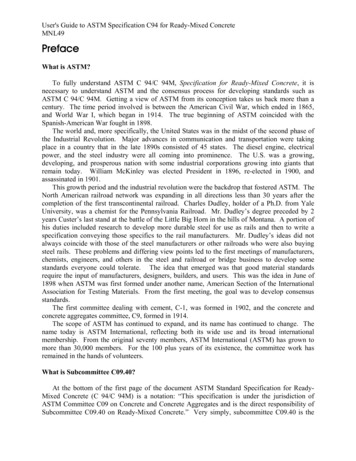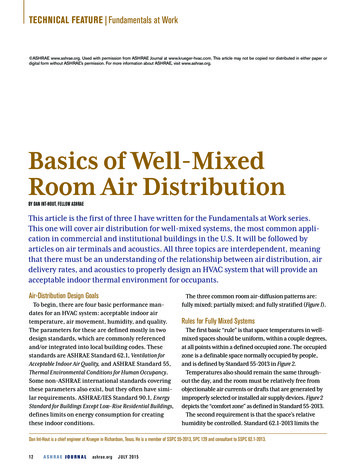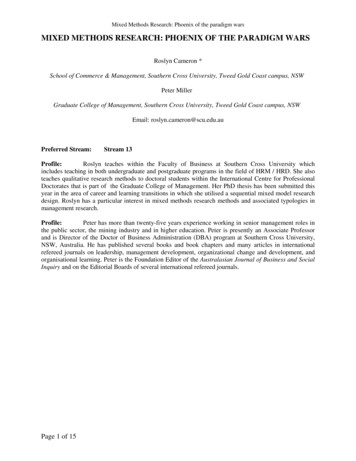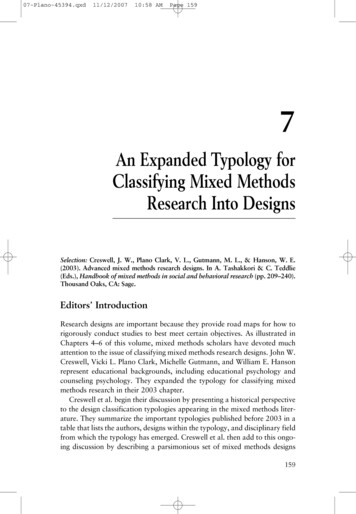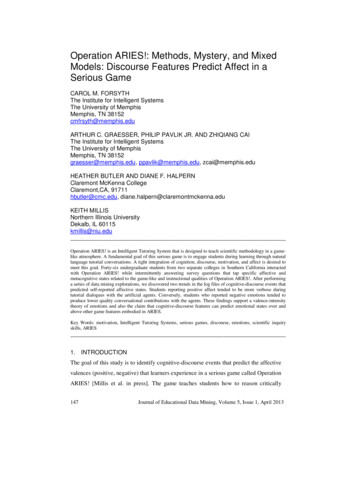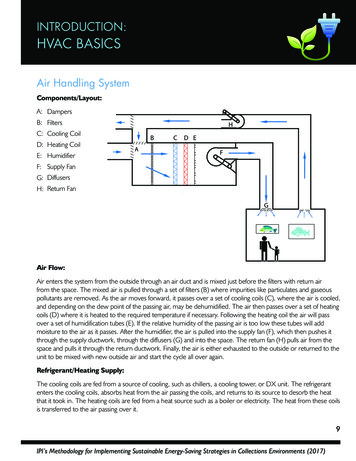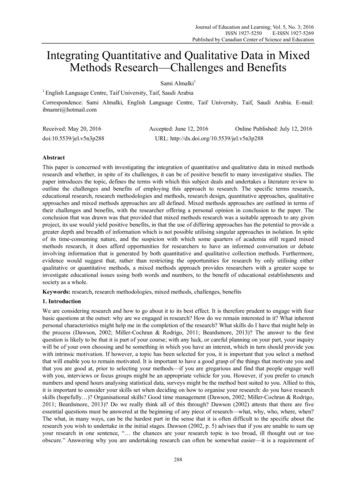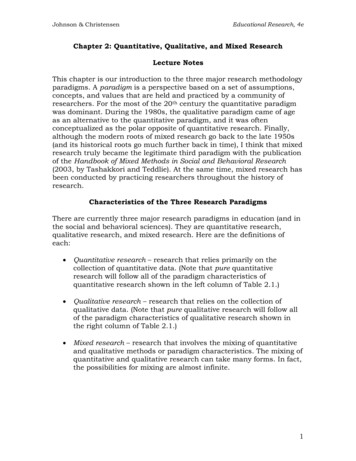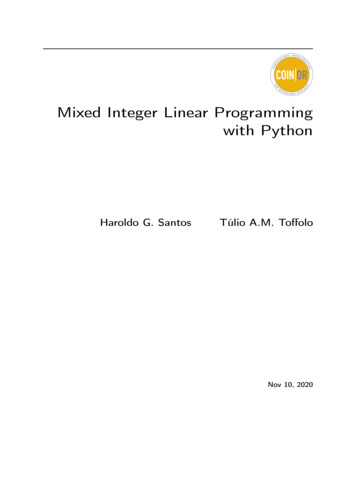
Transcription
An Introduction to Mixed MethodsResearchby John W. Creswell, Ph.D.University of Nebraska-LincolnSSP, University of Nebraska-LincolnMarch 9, 2007 Please do not duplicate or use these slides without the express permission of the author.
Office of Qualitative and Mixed Methods Research(OQMMR), Educational Psychology, UNL Purpose: To provide consultation on qualitative and mixed methods research, help scholars develop proposals for funding,and help conduct and evaluate funded projects.5 Ph.D.s: Creswell, Plano Clark, Lu, Green, Shope; 2 RA’sBegan 5 years agoCurrent projects in health sciences, physics, language arts,family/child research, educational assessment, veterans affairsFunding sources: NIH, NSF, Dept of Veterans Affairs, NationalDepartment of Education, Kellogg Foundation, EsperanceFamily Foundation, NE Dept of Education23 funded projects since opening; 28 journal publications and 5books or book chaptersEditorial Office of the Journal of Mixed Methods ResearchSelf-supporting research office2
Topics that I address in my mixed methodsclasses and workshops: Core idea of mixed methods researchAssumptions about research neededWhen to use mixed methods researchBasic componentsMixed methods literaturePhilosophical assumptionsMixed methods designsCriteria for choosing a designProcedural challenges in using designsStandards for evaluationFuture research3
Understanding the core idea of mixed methodsresearchQuantitative DataQualitative DataMethodology(called MixedMethods Research)4
Learning the assumptions about researchneeded to conduct this form of inquiry Qualitative is legitimate Knowledge of qualitative research. Methodology evolves Diversity in methodology Times when quantitative and qualitativeinadequate5
Identifying situations in which mixed methodsresearch is needed You are measuring a concept on an instrument.You have a sense that scores are not telling youthe entire story. If you just asked a few peopleabout the concept you might obtain a betterunderstanding mixed methods research providesa more complete understanding of the researchproblem than either quantitative or qualitativealone.6
Identifying situations in which mixed methodsresearch is needed You look over the instruments available to study a concept.They were developed from a different sample/populationthan the one you are studying. You consider that you willneed to develop an instrument before you can administer itto your sample Mixed methods is a methodology fordeveloping better, more context specific instruments. You have gathered data about a factors that predict aconcept on several instruments. Although you havegeneral information about the importance of predictors,you can only guess as to what explains why the resultsoccurred Mixed methods helps to explain results (orhow mechanisms work) in causal models.7
Identifying situations in which mixed methodsresearch is needed You are conducting an intervention study. You have anintervention that was developed by other researchers. Youare not certain that it will work with the sample you arestudying Mixed methods is a way to explore first todetermine if an intervention will work. We want to evaluate the performance of an organization.This calls for understanding the expected outcomes of theorganization (needs assessment), designing someinstruments to measure those outcomes, and then helpingto explain why the outcomes occurred Mixed methods isan approach to tie together several steps in an evaluationprocess.8
Learning the basic componentsinvolved in mixed methods research Mixed methods research is a methodology forconducting research that involves collecting,analyzing, and integrating quantitative and qualitativeresearch in a single study or a longitudinal program ofinquiry. The purpose of this form of research is that bothqualitative and quantitative research, in combination,provide a better understanding of a research problemor issue than either research approach alone.9
It is a research methodology The entire process of research Philosophical assumptions of inquiry Research questions Data collection Data analysis Data interpretation Data reporting10
It involves quantitative researchA research approach that involves: Variables, hypotheses, questions Instruments, closed-ended questions, reliability,validity Statistical analysis Generalizability, replicability, control, and lack ofbias11
It involves qualitative researchAn inquiry approach which includes: Central phenomenonBroad, general questionsViews of participantsReciprocity and respectDescription and themesInterpretationPersonal reflexivityFlexible structureMeaning or advocate for groups/individuals12
It involves collecting both quantitative andqualitative data Quantitative data InstrumentsChecklistsRecords Qualitative data InterviewsObservationsDocumentsAudio-visual materials13
It involves quantitative and qualitative dataanalysis Quantitative analysis Use statisticalanalysis,For descriptionFor comparinggroupsFor relating variables Qualitative analysis Use text andimages,For codingFor themedevelopmentFor relating themes14
It involves mixing the dataConverge data:QualResultsQuanConnect data:QualQuanResultsEmbed the data:Quan dataQual data15
It may consist of a single study or multiplestudiesSingle Study:QualQuanResultsMultiple Studies:QuanQuanStudy 1QualStudy 2QualStudy 3Study 416
Recognizing the body of mixed methodsliterature 1988, 1989 – books, articles by sociologists, evaluatorsAccelerated interest in 1990s14 booksJournalsConference papersMethodological journal article publicationsEmpirical journal article publicationsUS and international interest17
18
Designing and Conducting19
Editors: John W. Creswelland Abbas TashakkoriManaging Editor: Vicki L.Plano ClarkEmail: vpc@unlserve.unl.edu
Topics addressed in this body ofliterature Paradigm use Research designs Threats to rigor of the designs Sampling procedures Data analysis approaches Writing study aims, research questions Notation system Interdisciplinary team research Writing mixed methods studies Evaluating mixed methods studies21
Examining the philosophical assumptionsbehind mixed methods researchWorldview or philosophy (e.g., attitudes and beliefsabout knowledge, such as constructivism, postpositivism)Theoretical lens (e.g., feminist, racial)Methodological approach (e.g.,experiemental, survey, ethnography, mixed methods)Methods of data collection (e.g.interviews, focus groups)Adapted from Crotty M. The foundations of social research: Meaning and perspective in the research process. 22London: Sage, 1998.
Learning about aspects of a worldview orparadigm How we see reality in this world (ontology) How we know what we know (epistemology) How we view the role of values (axiology) How we conduct the procedures of research(methodology) How we view the use of language in research(rhetorical)23
Understanding four typical worldviewsPostpositivism Determination Reductionism Empirical observation andmeasurement Theory verificationConstructivism Understanding Multiple participant meanings Social and historicalconstruction Theory generationAdvocacy/Participatory Political Empowerment issue-oriented Collaborative Change-orientedPragmatism Consequences of actions Problem-centered Pluralistic Real-world practice oriented24
Understanding the different worldviewstances in mixed methods research: Different stances: Single worldview – pragmatism, transformativeemancipatory (advocacy/participatory) Multiple worldviews made explicit Worldviews change depending on type of design25
Learning about the types of mixed methodsdesigns typically used in researchI. Triangulation Mixed Methods DesignQUANData andResults InterpretationQUALData andResultsII. Embedded Mixed Methods DesignQUANPre-testData andResultsQual ProcessQUANPost-testData andResults26
III. Explanatory Mixed Methods DesignQUANData andResultsFollow-upqualData andResultsIV. Exploratory Mixed Methods DesignQUALData andResultsBuildingquanData andResults27
Learning about the concurrent TriangulationDesign One-phase project Concurrent data collection Combine results Intent is to merge two separate “strands” of data28
Concurrent Triangulation Design Visual ModelProcedure 9.Jrvey stn rt1 JrFric:bservationc:ha:klist Chart audits StatisticalanalysisProcedureProductQUANdata collectionQUANdata analysis Nurrericrl t Teststatistic SEM Semic;tn rt1 JrFriinterviews Cbservations Docum01ts Artifacts Ceding Tt"ematicanalysisRESULTSCo11paring resultsCompositeModelProductQUALdata collectionlQUALdata analysis Text data I m (JP. rl;it" Cedes Tt"erres GROUNDEDTHEORY
Learning about the Embedded Design Supportive role of one type of data or both forms ofdata (mixed methods within an experiment, case study,narrative study, correlational design) Concurrent or sequential data collection One phase or two phases Intent of enhancing the design30
Embedded Research DesignExperimentInterventionQuanData collectionPre-testQuanData collectionPost-testProcess – collectionand analysis of qualitativedata(before, during, after trial)31
Embedded Design within an ExperimentFlow of the experimentExperimental MethodologyqualbeforeinterventionProcedures: One-onone semi-structuredinterviews Thematic analysisProducts: Transcripts Developed interventiontreatmentQUANQUANPre- Intervention Post- &Follow-upMeasureMeasuresFollow-upProcedures: Three groups: control group, complianceIntervention group, alliance interventiongroup – group comparisons Outcome measures: 1) attitudes towardmedication 2) adherence to treatment3) avoidance of relapse DAI measure completed 3 times (pre, post,& follow up) Products:Numerical item scoresChange scoresTest statisticsqualafterinterventionProcedures: One-on-one semistructured interviews –exiting the trial,participants from twoexperimental conditions; Thematic analysisProducts: Transcripts Themes and quotesOverall resultsandinterpretationProcedures: Discuss treatmenteffectiveness Discuss themes incontext of interventionsand outcomesProducts:Discussion32
Learning about the Explanatory SequentialDesign? Sequential data collection Two-phase project Quantitative phase first; qualitative, second One phase builds on other phase Intent: to explain results or to select participants tobetter understand results33
An Explanatory Sequential DesignQuan itativetDataCollection(quan)QuantitativeData Analysis(quan)Case SelectionQualitativeData Analysis(QUAL)Quantitative AnalysisCase SelectionQualitative AnalysisInterpretation –based on quanand QUAL results QualitativeDataCollectionQuantitative Data*Number of cigarettesCES-D6Qualitative Data*Semi-structuredinterviews, audiorecorded andtranscribed* Data collected 10 timesover the course ofacalendar year for 40participantsGraphic plot of CESD6 scores over timefor each participantGraphic plot ofcigarettes/day valuesover time for eachparticipantSelected 5 casesmaximallyvaryingIdentified criticalmonths in whichsmoking variedDescription of eachcaseIdentification of lifeevents occurringduring criticalmonths wheresmoking increased ordecreasedThematic analysis oflife events for eachcaseCross-case thematicanalysisSource: Creswell, Plano Clark, Shope, McVea. (in progress)InterpretationWhy did changes insmoking occur?
Learning about the Exploratory SequentialDesign Sequential data collection Two-phase project Qualitative phase first; quantitative, second One phase builds on other phase Intent: to first explore in order to develop aninstrument, to identify categories, taxonomy forfollow up35
Phase I Qualitative Research - Year 1Qualitative Data CollectionQualitative Data AnalysisQualitative FindingsPhase II Quantitative Research - Year 2Quantitative Instrument DevelopmentUnstructured Interviews 50 participants8 observations at the site16 documentsText Analysis: Using QSR N6Development of codes and themesfor each siteCreate approximately a 80-iteminstrument plus demographicsAdminister survey to 500 individualsQuantitative Test of the InstrumentQuantitative ResultsDetermine factor structure of items andconduct reliability analysis for scalesDetermine how groups differusing ANOVA testExploratory Sequential Design
Identifying criteria for choosing a design Intent for conducting mixed methods research Concurrent (each strand stands alone then brought together) or sequential (one strand builds on theother)Emphasis or priority given to one strandNature of research questionsResources availableStakeholders in field37
Understanding the procedural challenges inusing the designs Contradictory findingsData integrationSample selectionSample sizeIntroducing biasTimeIRB support38
Recognizing standards for evaluating the“quality” of a mixed methods study Collection of both quantitative and qualitative data (in response to quantitative and qualitativequestions)Mixing of the two forms of dataRigor of quantitative and qualitative approachesContribution to the mixed methods literatureUse of mixed methods terms39
Needed research on mixed methods Visual diagrams and notation system Understanding types of designs, procedures (e.g., mixed methods questions), and reasons for mixed methodsUnderstanding issues (threats to rigor) arising in designsEmerging language of methodologyAdaptation to different fields of studyWorldview perspectivesInferences in mixed methods researchSkills neededFunding source requirements and guidelinesInternational perspectivesWriting mixed methods studiesCollaborative research and team research40
Additional ReadingsBooks: Creswell, J. W., & Plano Clark, V. L. (2007). Designing and conducting mixedmethods research. Thousand Oaks, CA: Sage.Creswell, J. W. (2003). Research design: Qualitative, quantitative, and mixedmethods approaches (2nd ed.). Thousand Oaks, CA: Sage Publications.Greene, J. C., & Caracelli, V. J. (Eds.) (1997). Advances in mixed-methodevaluation: The challenges and benefits of integrating diverse paradigms. NewDirections for Evaluation, Vol. 74. San Francisco, CA: Jossey-Bass Publishers.Mertens, D. M. (2004). Research methods in education and psychology: Integratingdiversity with quantitative and qualitative approaches (2nd ed.). Thousand Oaks,CA: Sage Publications.Tashakkori, A. & Teddlie, C. (1998). Mixed methodology: Combining qualitativeand quantitative approaches. Thousand Oaks, CA: Sage Publications.Tashakkori, A. & Teddlie, C. (Eds.) (2003). Handbook of mixed methods in socialand behavioral research. Thousand Oaks, CA: Sage Publications.41
Additional ReadingsArticles and Chapters: Caracelli, V. J., & Greene, J. C. (1993). Data analysis strategies formixed-method evaluation designs. Educational Evaluation and PolicyAnalysis, 15 (2), 195-207.Creswell, J. W., Plano Clark, V. L., Gutmann, M., & Hanson, W.(2003). Advanced mixed methods research designs. In: A. Tashakkori& C. Teddlie (Eds.), Handbook of mixed methods in social andbehavioral research (pp. 209-240). Thousand Oaks, CA: Sage.Greene, J. C., Caracelli, V. J., & Graham, W. F. (1989). Toward aconceptual framework for mixed-method evaluation designs.Educational Evaluation and Policy Analysis, 11 (3), 255-274.Morgan, D. L. (1998). Practical strategies for combining qualitativeand quantitative methods: Applications to health research. QualitativeHealth Research, 8 (3), 362-376.Morse, J. M. (1991). Approaches to qualitative-quantitativemethodological triangulation. Nursing Research, 40, 120-123.42
An Introduction to Mixed MethodsResearchby John W. Creswell, Ph.D.University of Nebraska-LincolnSSP, University of Nebraska-LincolnMarch 9, 2007 Please do not duplicate or use these slides without the express permission of the author.
Mar 09, 2007 · 3 Topics that I address in my mixed methods classes and workshops: Core idea of mixed methods research Assumptions about research needed When to use mixed methods research Basic components Mixed methods literature Philosophical assumptions Mixed methods designs Criteria for

